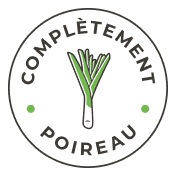Since some times now, because of diverse work, the question about the removal of dairy products is back. Some goes into demagogy and say that milk and dairy products are made for veal. That it's toxic for the human body! But, what is this really about?
Before all, we have to say that many abuse over daily cheese rations eaten. These are rich in calories, lipids and sodium. Three elements to eat with moderation. In fact, 50 g of cheddar cheese (equivalent of a portion of the size of two school eraser) contains 200 kcal, 17 g of lipids, which 12 g of saturated, 12 g of proteins and 350 mg of sodium. To obtain the equivalent in energy, you'll have to eat almost 9 whole leeks!
It's imporant to say that most of dairy porducts contains lactose. For an important part of the population, it creates gastrointestinal symptoms. Lactose, principal milk carbohydrate source, isn't directly absorb by the body. It needs to be metabolized by an enzyme, the lactase. Then, glucose and galactose created are then digested. The maldigestion of lactose is pretty common. A great proportion of the wroldwide population see its lactase rate decreased after childhood. So, the lactose portion not digested will be fermented with microbiota (bacterias in the digestive tract) which can cause bloating, flatulence and abdominal discomfort. The term "lactose intolerance" is a diagnosis set by a physician when maldigestion symptoms of lactos get's worse. To cure it, we can take digestive enzyme pills, dairy product without lactose or milk substitute like one made of cereals richer with calcium and D vitamin. Generaly, firm cheese has few or no lactose. Yogurt contains bacterias which help the digestion of lactose and so decreases gastrointestinal symptoms.
Researches shows that the daily integration and progressive of small quantities of foods with lactose increase its tolerance and can reduce on long terms gastrointestinals symptoms. Sinc lactose also act as a prebiotic, it's interesting to try it out!
You should also know that, sometimes, the intolerance is momentary. In fact, intestinal flu, some medications or foods intoxications can create a transient maldigestion of lactose. Once back on your feet, it's possible to gradually take back dairy products.
Finally, we have to distinguish milk allergy from maldigestion or overconsumption.
Milk allergy is an excessive reaction of the immune system to proteins found in milk. It's pretty rare and affect few adults. Generally, it can be found in 2 to 3% of new-borns. Milk allergy for kids tend to show up before the age of 3. The allergy can be showed by urticaria, rash, eczema, diarrhea or constipation, nasal congestion, cough, difficulties to breath and vomiting. It's important to see a doctor right away and obtain a diagnosis, because the removal of these foods on a baby or a young children could lead to nutritional deficiencies that could compromise the growth and health. A consultation with a nutritionist dietitian is needed to adjust foods consequently and be sure to recognize well products that may contains milk or product made with a milk base.
To be short, dairy products are foods just like others. It has advantage and disadvantage. It has it's place in an healthy alimentation. Depending on our tolerance and our health state, we can eat it with tranquility. I my opinion, we can't demonize nor idealize it!




